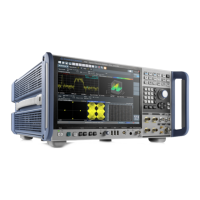Measurements and Results
R&S
®
FSW
154User Manual 1173.9411.02 ─ 43
Table 7-9: Measurements performed depending on the number of adjacent channels
Number
of adj.
chan.
Measurement results
0 Channel powers
1
●
Channel powers
●
Power of the upper and lower adjacent channel
2
●
Channel powers
●
Power of the upper and lower adjacent channel
●
Power of the next higher and lower channel (alternate channel 1)
3
●
Channel powers
●
Power of the upper and lower adjacent channel
●
Power of the next higher and lower channel (alternate channel 1)
●
Power of the second next higher and lower adjacent channel (alternate channel 2)
… …
12
●
Channel powers
●
Power of the upper and lower adjacent channel
●
Power of all the higher and lower channels (alternate channels 1 to 11)
In the R&S FSW display, only the first neighboring channel of the carrier (TX) channel
is labeled "Adj" (adjacent) channel; all others are labeled "Alt" (alternate) channels. In
this manual, "Adjacent" refers to both adjacent and alternate channels.
The measured power values for the TX and adjacent channels are also output as a
table in the Result Summary window. Which powers are measured depends on the
number of configured channels.
For each channel, the following values are displayed:
Label Description
Channel Channel name as specified in the "Channel Settings" (see "Channel Names"
on page 177).
Bandwidth Configured channel bandwidth (see "Channel Bandwidth" on page 174)
Offset Offset of the channel to the TX channel (configured channel spacing, see "Channel
Bandwidth" on page 174)
Power
(Lower/Upper)
The measured power values for the TX and lower and upper adjacent channels. The
powers of the transmission channels are output in dBm or dBm/Hz, or in dBc, relative
to the specified reference TX channel.
Retrieving Results via Remote Control
All or specific channel power measurement results can be retrieved using the
CALC:MARK:FUNC:POW:RES? command from a remote computer (see
CALCulate<n>:MARKer<m>:FUNCtion:POWer<sb>:RESult? on page 837).
Alternatively, the results can be output as channel power density, i.e. in reference to
the measurement bandwidth.
Furthermore, the measured power values of the displayed trace can be retrieved as
usual using the TRAC:DATA? commands (see TRACe<n>[:DATA] on page 1143). In
Channel Power and Adjacent-Channel Power (ACLR) Measurement

